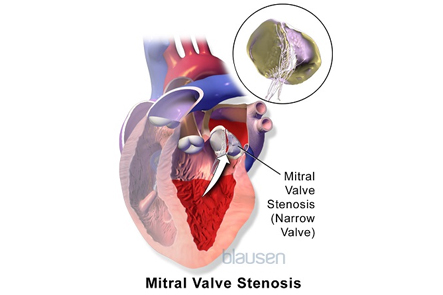A narrow mitral valve that does not allow sufficient blood flow
The mitral valve allows blood to flow between the two left chambers of your heart, the left ventricle and the left atrium. Mitral stenosis does not allow the valve to open properly, decreasing blood flow through the heart. This can lead to pulmonary hypertension, atrial fibrillation, or heart failure.
Our Structural Heart and Valvular Disease Program offers innovative minimally invasive treatment options for heart valve diseases, such as mitral stenosis.
Valvular Stenosis
If a valve becomes narrow, stiff or thickened, the heart must work harder to force blood through the smaller opening. A valve that has become narrowed or thickened can compromise blood flow. This condition is called valvular stenosis.
What are mitral stenosis symptoms?

-
Coughing up blood
-
Edema, swelling in the feet or legs
-
Shortness of breath
What can cause mitral stenosis?
The most common cause of mitral stenosis is rheumatic fever, which is rare in the United States. Calcium deposits that build up on the valve or untreated strep infections can also cause mitral stenosis.
Tests
Diagnosing mitral stenosis is the first step to developing a treatment plan. Our specialists may recommend one or more diagnostic and imaging procedures.
Cardiac Catheterization
Cardiac catheterization is a minimally invasive way to diagnose and treat a variety of heart and vascular conditions by guiding thin, flexible tubes called catheters through blood vessels to problem areas.
Chest X-Rays
Chest X-rays use a small dose of radiation to create pictures of the structures inside the chest, including the lungs, heart, and chest wall.
Echocardiogram
An echocardiogram uses high-frequency sound waves to create images of the heart.
Electrocardiogram (ECG)
An electrocardiogram, also known as an ECG, measures the heart’s electrical activity.
Magnetic Resonance Imaging (MRI)
Magnetic resonance imaging, better known as cardiac MRI, is a combination of radio waves, magnets, and computer technology to create images of your heart and blood vessels.
Stress Tests
Stress tests are used to assess how your heart works during physical activity. There are several types of stress tests, including treadmill or bike stress tests, nuclear stress tests, stress echocardiograms, and chemically induced stress tests.
Treatments
Our heart and vascular teams work together and with other specialties to develop and implement individualized plans to treat a wide variety of conditions. This could include medication or more advanced treatments.
Mitral Valve Disease Treatments
Mitral valve disease treatments may include medication, minimally invasive procedures and surgery to treat a damaged valve.
Mitral Valvuloplasty
Mitral valvuloplasty improves blood flow through the heart to the lungs and body by opening a narrow or stiff heart valve.
Percutaneous Valve Treatments
Percutaneous valve procedures use catheter-based methods to replace a damaged heart valve and are less invasive than traditional open-heart surgeries.
Our providers
Location: Change location Enter your location
-
Thelma Dianne Aguilar, AGACNP-BC MSN
Cardiac Surgery & Cardiac Electrophysiology
-
Dweep Barbhaya, MD
Hospital Medicine, Cardiovascular Disease & Internal Medicine
-
Orest Bohdan Bartoszyk, MD
Cardiology
-
Daniel James Dooley, MD
Cardiology
-
Marcus D. Hodge, MPAS PA
Cardiology
-
Stephanie Schwalm Jacobs, MD
Cardiology
-
Thomas Edward MacGillivray, MD
Thoracic Surgery & Cardiac Surgery
-
Kathleen Ann McClanahan, ANPBC MSN
Gastroenterology, Cardiac Surgery & Cardiology
-
Diego Andres Medvedofsky, MD
Cardiology
-
Melissa D. Mohamed, AGACNP-BC MS
Cardiology
-
Cierra Catherine O'Neill, MPAS PA
Cardiac Surgery
-
David McNeely Roberts, MSPAS PAC
Cardiology
-
Maritess Almirante Teston, AGACNP-BC
Cardiology & Cardiac Electrophysiology
-
Alfred Carroll Burris, MD
Cardiovascular Disease & Interventional Cardiology
-
Camellus Okwochi Ezeugwu, MD
Cardiology
-
Sameer Sofat, MD
Cardiology
Related services
Insurance
MedStar Health accepts most major health insurance plans. If you are uncertain as to whether your individual health insurance plan is accepted at MedStar Health, please call your insurance company.









